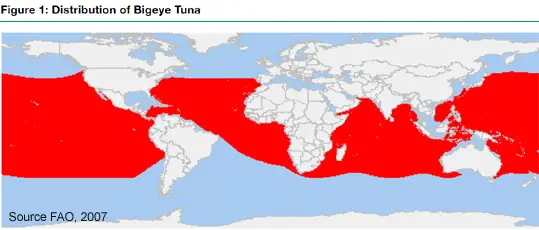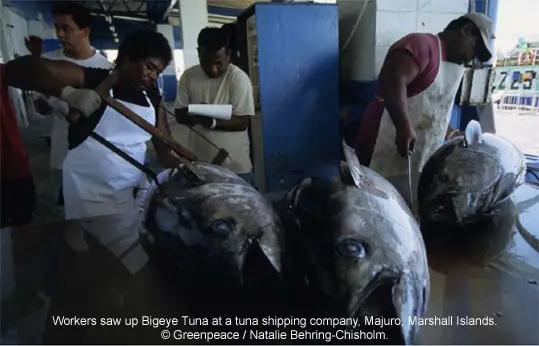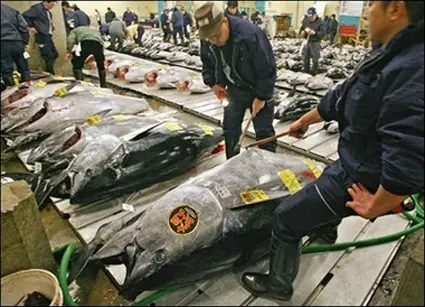Bigeye Tuna, Thunnus obesus is a widely traded and highly migratory species, of which separate stocks are considered to exist in the Atlantic, Indian, Western and Central Pacific, and Eastern Pacific Oceans. It is an important target species for industrial longline tuna fisheries on the high seas and smaller-scale longline, purse seine and ring-net fisheries in national waters. Increasingly, Bigeye Tuna is also taken as bycatch in purse seine fisheries fishing for Skipjack Tuna Katsuwonus pelamis and Yellowfin Tuna Thunnus albacares using fish aggregating devices.
The mature fish taken by longline fleets attracts high prices on the sashimi markets of Japan and, increasingly, in Europe and North America. Juvenile Bigeye Tuna taken by purse seine fleets is used in the lower value canning industry.

Markets
Bigeye tuna is sold as sashimi and sushi, as loins, as canned tuna, in foil pouches and as speciality products such as steaks. Traditionally, Japan has been the major market for sashimi and sushi-grade Bigeye Tuna with the USA being the major market for canned tuna. Domestic consumption in the flag State of the catching vessels is also a significant and, in some cases, growing market.
For example, in Sri Lanka, tuna is a popular product and is sold fresh, frozen dried and cooked/baked to traditional recipes (Anon., 2006) and domestic consumption in the Republic of Korea (South Korea) of all tunas more than trebled for both canned and sashimi-grade product in the 15 years to 2005 (Korean Deep Sea Fisheries Association, 2006).
Catch
Reported catch of Bigeye Tuna peaked at 455 000 tonnes in 2002 according to FAO data. The total catch of 403 000 tonnes in 2005 was the lowest recorded catch in the past decade. Estimates of catches made by the four RFMOs responsible for managing the species suggest that in that year catch totalled 432 000 tonnes. Both sets of data confirm that around 60% is taken in the Pacific Ocean, around 26% in the Indian Ocean and the remaining 14% in the Atlantic Ocean.

Stocks
Globally, Bigeye Tuna is classified as Vulnerable by the IUCN13 while the Pacific Ocean stock is classified as Endangered (IUCN, 2006). The following discussion on stock status relies on the latest scientific advice available from the scientific advisory bodies of the RFMOs [Regional Fisheries Management Organisations ] responsible for each of the four stocks. Each of the Bigeye Tuna stocks are considered fully exploited or overfished. In at least three of those stocks, overfishing is occurring. There is no scope for sustained increased catches, and there is a need to reduce fishing mortality in at least three of the stocks.
By and large, the members of the four RFMOs responsible for Bigeye Tuna management have failed to heed the management recommendations of their scientific advisory bodies. They have delayed, deferred or failed to reach agreement on management measures that have a high chance of achieving the cuts in the catch and/ or effort identified as necessary in light of the stock assessment outcomes. The management response has been far from precautionary and has failed to reflect the best available scientific advice. The failure to implement management measures consistent with the scientific advice is largely a reflection of the failure to establish agreed objectives and decision rules as part of a management strategy.

Conclusion
Dr Simon Cripps, Director of WWF’s International Marine Programme, says “Science demands a sharp reduction in the catch of Bigeye tuna, but over the past decade this advice has been ignored… Once again the high seas are being fished out, and unless global intervention is effective, important fish stocks will be lost forever.”
A report from TRAFFIC, the wildlife monitoring network, and WWF shows that government members RFMOs, the main international mechanism to regulate fishing on the high seas-have generally been slow to respond to scientific advice, have failed to address overfishing of Bigeye tuna and have not met their legal obligations under the United Nations Fish Stocks Agreement. There is real concern that Japan’s huge appetite will take the most sought-after stocks to the brink of commercial extinction unless more rigid quotas are agreed. The collapse of this species will have a profound economic impact on fishing fleets, associated processing and trading industries and on a number of island States who rely on income from fishing fleet fees.
This material was sourced and extracted from: Lack, M. (2007). With an eye to the future: addressing failures in the global management of bigeye tuna. TRAFFIC International and WWF Australia.
